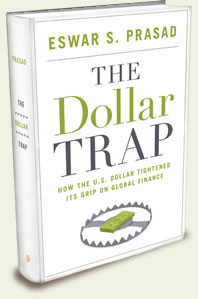The Dollar Trap
How the U.S. Dollar Tightened Its Grip on Global Finance
By Eswar S. Prasad
Pub Date: Feb. 1st, 2014
ISBN: 978-0-691-16112-9
Publisher: Princeton Univ.
Richly detailed study of global finances, examining how and why the dollar became the favored currency of international trade.
In 2008, when the financial markets nearly collapsed in the United States and then, continent by continent, around the world, something counterintuitive happened: Money flowed back into the U.S., as American investors pulled their money out of foreign commitments and foreign investors sought the relatively safe haven of the dollar, mostly as expressed through treasury bonds. “The dollar,” writes Brookings Institution senior fellow Prasad (Trade Policy/Cornell Univ.; co-editor: New Paradigms for Financial Regulation: Emerging Market Perspectives, 2012, etc.), “which should by all rights have plunged in value, instead rose sharply against virtually every other currency. It even rose against all other major reserve currencies except for the Japanese yen.” The dollar has weathered other challenges, as well, including the threat of a default on the part of Congress and, about the same time, the Standard & Poor’s 500 index rating cut, reflecting pessimism over the inability of the U.S. government to address debt. No other currency, Prasad argues, is as strong—adding, cautiously, “relatively speaking.” The result is that no other economy is positioned to supplant the dollar, a pointed thought insofar as China is attempting to expand its official currency, the renminbi, beyond its national borders. Prasad warns that nothing lasts forever, so the question is not whether the dollar will remain the leading reserve currency forever but, instead, how much time it has left to hold that position—presuming that some other currency rises to dominance or even that “the entire system of reserve currencies will be replaced by a different arrangement.” For international investors and economic policy wonks, particularly those following the development of Chinese economic strategy.

